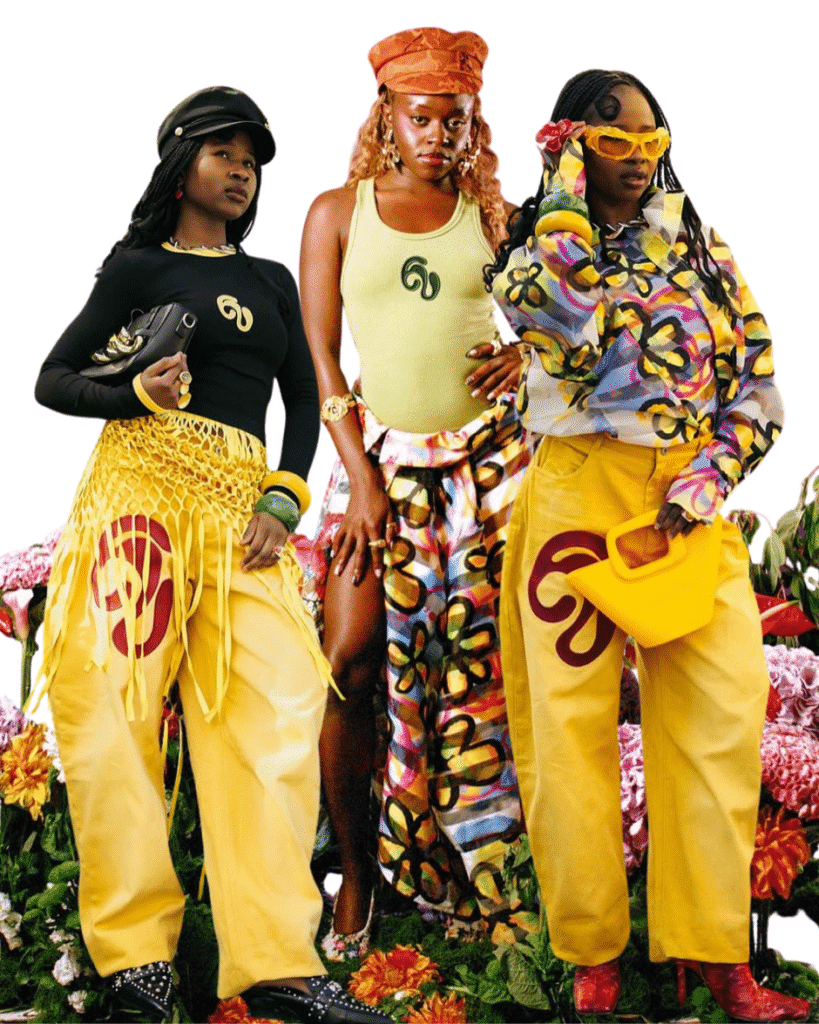
Remember when everyone had a white Air Force One, beige hoodies, wardrobes filled with white, beige, and black, grey interiors, clean branding? Minimalism was everywhere. But now, we’re all wearing printed sambas or Onitsukas in ten different colours. Our homes are loud again, our feeds feel chaotic, and brands are becoming a lot more bold.
But why is this? It’s because fashion swings like a pendulum. One era gets exhausting, and we go the other way. It’s not just about aesthetics; it’s about psychology. When life gets overwhelming, we crave control and that’s why minimalism thrives. But when the world feels dull or restrictive, we want to feel again. Cue maximalism.
Fashion has never stood still. And in 2025, maximalism has made a strong comeback but this time, it has an Afro-maximalist edge.

What Makes It Afro-Maximalism?
Simplicity has rarely been a choice in African fashion. Our histories, cultures, and identities have always been layered and rich. What may seem like “too much” is, in reality, an archive of meaning a way of presenting stories, celebrating life, reclaiming space, and embracing abundance as a necessary assertion of who we are.
• Prints that tell stories: Ankara, kente, adire, and aso-oke are more than fabric; they’re archives of heritage, history, and identity.
• Layered abundance: Beads stacked, jewellery layered, colours clashing yet cohesive, this is how African communities have always adorned themselves.
• Cultural assertion: In a world that once silenced boldness, Afro-maximalism is reclamation. It’s saying, we will not shrink ourselves.
• Global influence: From Kai Collective’s Gaia print to Rich Mnisi’s bold silhouettes and Lisa Folawiyo’s embellished fabrics, Afro-maximalism is setting trends across runways worldwide.

Maximalism as a Feeling
For most people, fashion is just design or trend. But for others, fashion is a living art, a breathing canvas where every fabric holds a soul. Afro-maximalism takes this further: it isn’t just more is more, it’s meaning is more.
Maximalism is the healing of your inner child, dressing the way you once wanted to dress without rules. It’s fun, playful, layered, and unapologetic. And when tied to African culture, it becomes something greater, a way to honour heritage while pushing boundaries.
The Cycle: Minimalism vs Maximalism
Minimalism focuses on clean lines, neutral tones, capsule wardrobes. It promotes control, refinement, and subtlety, the quiet luxury that dominated for years. But maximalism pushes back with bold colours, loud patterns, statement jewellery, chaotic layering that somehow makes sense.
The pendulum keeps swinging. After the pandemic, people craved colour and chaos again, experimenting with textures, patterns, and accessories. And Afro-maximalism rose naturally, because it’s always been there, not a trend, but a truth of how African identities have always expressed themselves.

Why Now?
Maximalism is back because nostalgia hits differently. People are tired of muted, minimal design. They crave the loud, playful chaos of the 90s and 2000s, and Afro-maximalism delivers that with deeper cultural meaning. From candy-wrapper brights to jewel-toned fabrics, it’s dopamine for the eyes in a world that often feels too serious.
Afro-maximalism is layered, dynamic, colourful, but never boring. It’s cohesive and chaotic, curated yet free. It’s not just about standing out; it’s about telling stories with every stitch, colour, and clash. And right now, it’s the boldest and most authentic wave in global fashion.
So next time you see clashing prints, over-the-top jewellery, or colours that make you do a double take, don’t call it chaos, call it Afro-maximalism.